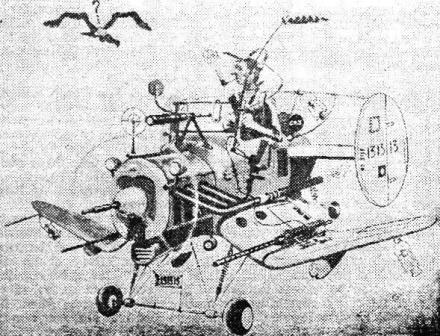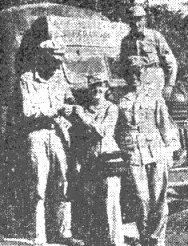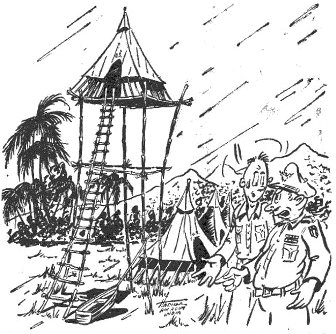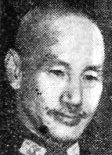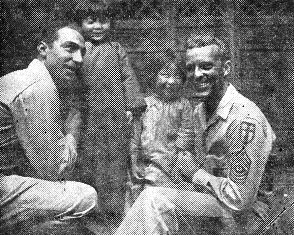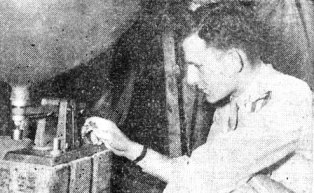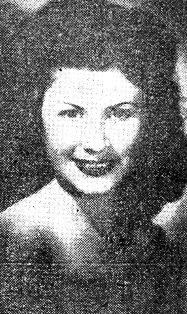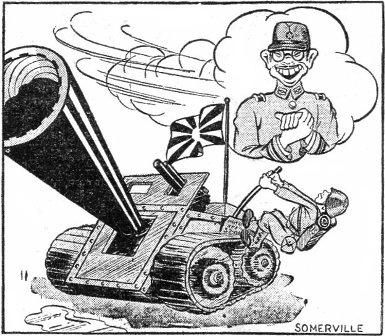


VOL. II NO. 44 REG NO. L5015 DELHI, THURSDAY JULY 13, 1944.
|
Cloaked by nightfall, Super-Forts of the 20th Bomber Command lumbered onto their secret runway in China, lifted themselves towards the stars and pointed their noses toward Japan. The date: July 7, seventh anniversary of China's declaration of war against the Nipponese. The giant B-29's were to remind the Japs of the event with crashing decisiveness by launching their second mission against the enemy Empire.
As on June 15, when they punished Yawata, the B-29's again streaked to the "Pittsburgh of Japan," located on the island of Kyushu. Here they landed a second savage blow, in addition to sowing destruction upon two of Kyushu's other vital war centers - Sasebo and Omura.
Sasebo is a tempting, lucrative target. Besides naval installations (Sasebo is one of Japan's three largest bases) there is here one of the Imperial Navy's chief arsenals and factories producing medium and heavy electrical equipment, arms, munitions and aircraft.
Other Super-Forts struck at Laoyao, coal and shipping port on the North China Coast, and Hankow, principal supply base for Jap operations in Eastern China.
While the first raid by Brig. Gen. Kenneth Wolfe's strategic global bombing unit cost four B-29's, all of the heavyweights returned to their base this time, reporting weak fighter opposition and meager anti-aircraft fire as they swept over Japan.
In a statement on the seventh anniversary of China's war, Gen. H. H. Arnold declared prophetically: "In the near future, we will be striking Japan with increasing frequency and increasing destructiveness from every side. The Japanese who heard the whistle of our bombs from the new Super-Fortresses, who felt the blasts that tore apart their principal steel works, will now know there is no place left far enough from us to serve them as a hiding place."
Rains Fail To Aid Nip
NORTHERN BURMA - Uncle Joe Stilwell's pre-monsoon promise - "It may slow us, but it won't stop us" - was no farther from being broken this week as his heterogeneous Chinese, Chindit, and American forces continued to chew up the vanishing Myitkyina-Mogaung-Kamaing triangle in the face of the jungle deluge.
Activity in the Mogaung Valley, though not on a heavy scale, was widespread and frequent; and the Chinese and Chindits cut deeper into remnants of Jap strength. Organized resistance was cleared from the Kamaing-Mogaung Road, contact being made seven miles above Mogaung by one Chinese column moving down the artery and a second moving north from the captured bastion. East, west and south of Mogaung, the Chindits slapped Mr. Nip's ears back in a number of short, sharp engagements.
In besieged Myitkyina, the Chinese moved closer into the core of Jap resistance, principally from the south and west; the Yanks applied pressure from the north; while the Chindits on the east bank of the Irrawaddy, maintaining vigilance, on two occasions shot up rafts attempting to escape down the river.
Meanwhile, through breaks in the weather, American aircraft threw their weight into the attack during the last part of the week. Patches of visibility also brought out the Japs twice. The first enemy air effort caused minor damage. The second failed to reach its objective when Yank planes intercepted and shot down two Nips.
|
By SGT. SMITH DAWLESS Roundup Field Correspondent
ALONG THE LEDO ROAD - Little black box makes like gun.
Perched in a tree in an exclusive suburb of Myitkyina was Pvt. Thomas Fanning. Parked 20 feet away in a bamboo grove was his carbine. Armed only with his trusty Speed-Graphic, Tom was intent on shooting a ladder bridge that crossed a flooded nullah.
"Get outta there!" he hollered as animate forms appeared through his lens. The figures advanced. He looked up, swallowed hard, teetering on the limb. Three Japs were advancing upon him.
Here was a natural, instinct told him. But, even if he got a good shot, there would, alas, be no one to remove the films from his dead body and have them developed. In a flash, he saw his life cycle: from Signal Corps to single corpse.
Unexpectedly, time-honored Japanese traditions were shattered. The three interlopers shed rifles, rubbed their stomachs eloquently - a gesture that speaks a universal sign language.
His camera aimed menacingly at their middles, Tom dropped to the ground, retrieved his gun. "Okay, Tojo boys," he said, dazed by this sweet capitulation, "we'll feed you. Let's go."
Apparently the three Nips thought it Hell to go on being Sons of Heaven with empty bellies.
C.B.I. MAJOR'S KIN TIES ACE RECORD
The Roundup is in receipt of a loud and apparently justified bleat from Major T. S. Gabreski, attached to the Surgeon's Office at Base Section No. 1, CBI.
The bleat: Roundup, (and several other less well-known publications) have been saying that Maj. Robert Johnston and Capt. Don S. Gentile were the top aces of the ETO, with 27 and 23 kills, respectively.
The facts: As of June 17, Johnston had been tied by Lt. Col. Francis E. Gabreski, 26, Oil City, Pa., brother of our Gabreski. In addition to 27 Nazi planes destroyed in the air, Gabreski has two on the ground, which, we are informed, he is not claiming.
Goodness knows how many the colonel has by now. We like to be put right on these things.
Tengchung Faces Encirclement
SALWEEN FRONT - Tengchung, principal initial objective of the Salween campaign, was being encircled this week by the Chinese 20th Ground Army, while to the south, the 11th Army was on the offensive around
|
One attack southeast of Tengchung had hit within one half mile of the city, while other Chinese troops captured villages to the south and eat and were within 10 miles of the city from these directions. Northeast, 200 Japs had been surrounded and a hill outpost annihilated.
LINK UP EFFORT
One element of the Salween forces is at Chanchi, 25 miles west of Tengchung, and only 26 miles from Sadon, just over the Burma border, where some of Lt. Gen. Joseph W. Stilwell's troops are driving eastwards in an attempt to link up with the Salween forces to open up the old Burma Road supply line to China.
Highlight of the week's fighting was the spectacular storming of Shungshan mountain crests by 11th Army troops armed with flame throwers and bazookas, the first time these American weapons have been used in China.
ATTACK CLIFF POSITIONS
Chinese engineers wiped out wire entanglements with Molotov cocktails and dynamite charges, operating under a tactical plan proposed by Brig. Gen. Frank Dorn, whose American liaison group is operating with the Chinese. The attack went almost perpendicularly up the face of rain-drenched cliffs.
On two occasions, near Tengchung, tactical surprises resulted in the fall of enemy positions when the Japs left their defenses to escape torrential rains. The Chinese, through alert reconnaissance, promptly moved in without loss of a man.
The 14th Air Force continued to air-drop a heavy tonnage of supplies to the 20th and 11th Armies.
AWOL REWARD FOR LEDO TOILS
REPORT SURPRISES ENGINEER'S C.O.
|
AVIATION ENGINEERING BATTALION, BURMA - One guy who can sympathize with the frustrations of Sad Sack these days is Pvt. Robert E. Cronin.
For eight months, Cronin has been helping build the fabulous Ledo Road, wrestling with topography, weather and miscellaneous misery.
Cronin didn't expect a reward, mind you.
However, neither did he expect his company to receive a letter from Army authorities in Shangri-La listing him as AWOL.
Stated the letter, "Pvt. Robert E. Cronin was returned to military control at Camp Blank. Request service record and allied papers be sent."
Everyone in the company got a chuckle out of that. That is, everyone but Cronin. His outfit promptly replied that the "offender" had sailed with the outfit several months before and had turned in a fine record of achievement since coming to Burma.
|
The U.S. has announced that Japan faces further raids by B-29's similar to the two already undertaken by the Super-Forts. The B-29's can operate from CBI-land, as they did on the June 15 and July 7 expeditions, or from the newly-acquired bases in the Southwest Pacific. On this page are pictures of the new aerial threat to the dignity and peace of the Mikado and his subjects.
Both raids from the American Super-Airbase in China hit the Yawata Steel Works, where the industrial "Pittsburgh of Japan" is located. The first raid was estimated to have put a stop to one-tenth of Nippon's steel industry. Results of the second raid have not been announced. But the second visit took in the naval base at Sasebo and the district of Omura on the island of Kyushu, as well as Hankow and Laoyao in occupied China. Hankow is a supply port for East China. Laoyao is a coal distribution center.
Gen. Henry H. Arnold has announced that B-29's will be used in global operations as an aerial task force, similar to the fabulous Task Force 58 the Navy is now employing on the sea in the Southwest Pacific. This new command, he has said, will bomb Japan and carry out other duties to drive the Nipponese from the war.
The ceiling of the B-29 has never been given out, but it has been said that it can fly higher and faster and farther than any other known plane. The forays from China were described in just these word.
Arnold has said that one plane was shot down over the target in the June raid and that as far as is known the pieces are in Japanese hands. Whether the Nips will be able to obtain any information from the reconstruction of the plane is not known nor is the fate of the crew. Arnold said that the occupants are believed to have parachuted out after the plane was hit by ack-ack fire. No planes were lost in the bombing last week.
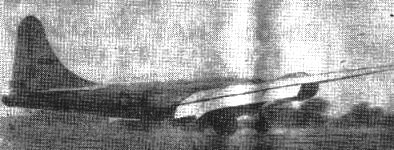 A Super-Fort lands perfectly, kicking up a cloud of dust as it hits the earth on landing. The nose wheel
is still off the ground.
A Super-Fort lands perfectly, kicking up a cloud of dust as it hits the earth on landing. The nose wheel
is still off the ground.
|
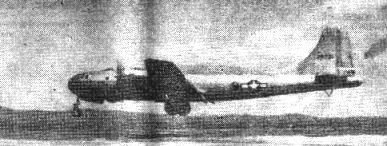 Here is the Yank giant of the skies taking off. Notice that the wheels are still down and how clearly
the front one is outlined.
Here is the Yank giant of the skies taking off. Notice that the wheels are still down and how clearly
the front one is outlined.
|
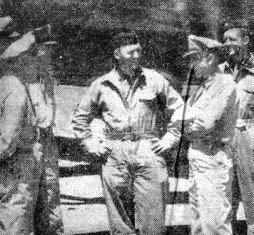 Brig. Gen. Kenneth Wolfe, 20th Bomber Command chief, arms folded, with Col. Jake Harmon, hands on hips.
Brig. Gen. Kenneth Wolfe, 20th Bomber Command chief, arms folded, with Col. Jake Harmon, hands on hips.
|
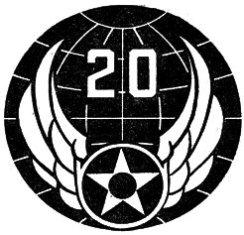
|
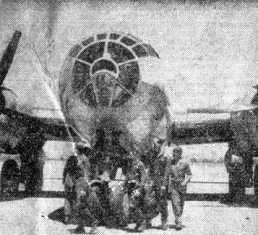 Here's a comparison between the size of the bomber crew and the nose of the Super-Fort, twice over Japan.
Here's a comparison between the size of the bomber crew and the nose of the Super-Fort, twice over Japan.
|
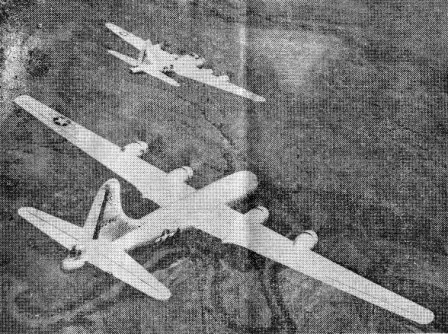 The B-29 shown aloft, with all its magnificence in size, armor and armament. The Flying Fortress shown in
the background is small by comparison.
The B-29 shown aloft, with all its magnificence in size, armor and armament. The Flying Fortress shown in
the background is small by comparison.
|
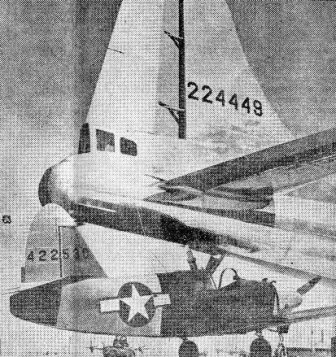 A ground comparison shows the size of the Arnold hope. The Culver Kaydet plane seems dwarfed by the giant's
tail.
A ground comparison shows the size of the Arnold hope. The Culver Kaydet plane seems dwarfed by the giant's
tail.
|
JAP RESISTANCE ENDS IN UKHRUL VILLAGE
KANDY, CEYLON - The Southeast Asia Command has announced that all organized Jap resistance at Ukhrul has ended and that British and Indian troops are in secure possession of the village.
Rearguards left to cover the retreat of the 31st and 15th Jap divisions, badly decimated, have been isolated, dispersed, or destroyed. On the Imphal-Ukhrul Road, 14 miles north of Imphal, two additional enemy positions have been cleared after fierce fighting, the communiqu states.
A unit of about 100 Japanese, trapped on the road some 24 miles from Imphal, attempted to break through road blocks with light tanks and artillery. About 50 were killed or captured and the rest escaped.
|
HARASS JAPS IN SUPPORT ROLE
EAC HEADQUARTERS - Effective air support continued to be given the ground forces of Lt. Gen. Joseph W. Stilwell in the Mogaung and Myitkyina areas during the past week by fighters, dive-bombers and medium bombers of Gen. Howard C. Davidson's 10th USAAF of EAC.
Heavy attacks were carried out by B-25's against points along the Myitkyina-Mandalay Railroad. Selected targets in the town of Myitkyina were also hit.
On July 4, fighters destroyed three enemy aircraft and damaged another on an airstrip near Lashio, while two days later a P-51 destroyed one Jap fighter and damaged a bomber in the air.
OVER IMPHAL
Operations of the Tactical Air Force were hampered by the weather. nevertheless, in the Imphal-Kohima area, fighters, fighter-bombers and dive bombers carried out attacks against enemy lines of communication and strong points selected by ground troops.
The Arakan area had visits from dive-bombers and fighters on July 3 and 4, heavy attacks being showered on Buthidaung, destroying a jetty, scoring direct hits on a supply dump, and strafing Jap troops.
CENTRAL BURMA
Over Central Burma, long-range twin-engine fighters of the Third Tactical Air Force destroyed locomotives and rolling stock. Both cannon and rocket projectiles were used. On July 2, P-38's scored numerous direct hits on the railroad between Ngapayin and Sagaing, and four days later had equal success against tracks between Wetlet and Ketky.
RAF Liberators on July 1, 6, and 7, bombed the freight yards at Mandalay with good results on each mission. Flames were visible up to 80 miles away after the last raid.
Throughout the week, regardless of weather conditions, USAAF and RAF troop carrier units attached to the 10th Air Force and Tactical Air Force, continued to pour in large quantities of supplies, ammunition and equipment to Allied troops in various parts of Burma.
The weather conditions over Burma during the week ending July 2 were the best seen since the monsoon ended. USAAF B-25's scored 47 direct hits in one raid during this period on the Mandalay-Myitkyina Railroad.
Prickly Heat Enjoying Vogue in CBI-Land
By S/Sgt. KARL PETERSON
Enjoying quite a vogue with American service personnel in India this season is that dear old friend prickly heat, heat rash, Asiatic crud, or "that (censored) (censored) (censored)."
Terminology varies with the severity of each individual's case. Found especially in large urban areas, this modern people's plague democratically strikes high and low, mighty and minion.
Crusading as ever for the welfare of all CBI dog tag wearers, therefore, the rampant Roundup this week sent its learned medical editor to the local station hospital for some pukka gen on causes, effects and cures (if any.)
|
The disease, it seems, has almost 100 percent incidence in severe areas, but mortality is negligible, if not nil, so it ranks as a pest rather than a killer. This excludes cases of guys being run down by lorries while engrossed in scratching, or asphyxiated by coking clouds of heat rash powder.
Prickly heat, technically, is a skin irritation. What causes it, Mr. Bones? Well, technically, we sure as hell don't know. There are theories - and theories. One is that the old hide is rankled by the dried salt of previous perspiration . . . logical enough.
Effects, on the other hand, are definite, violent, and strictly to type. An attractive red blotchy rash, like strawberry hives, covers your carcass, from toenails to hairline, centering on the inside of the arm joints, armpits, and - er, other friction areas. The victim then starts itching, bitching and twitching, develops a temper like a well-teased Bengal tiger and bags under the eyes from nights of whirling, dervish fashion, on a figurative bed of nails.
For surcease of these afflictions, there are literally hundreds of cures, all worthless. G.I. dispensaries offer calamine lotion and prickly heat powder, the latter containing zinc oxide, starch, boric acid and camphor. Calamine, liberally slapped on the torso, dries quickly to a coating of zinc oxide also leaving you all powdery white like a bagman in a flour factory. These are mere palliatives, however, skin-driers, and the lad who returns to his sweaty toils after treatment is soon prickly again.
Anything which stops perspiration is to the good, lying quietly and nakedly on one's bunk taking it easy brings relief, usually, but some say there are already too many India-based troops so engaged, and there is a war on, y'know.
Medical authority has two more ideas. Don't use soap in showering more than once daily, it exaggerates skin irritation; and get a little sun tan to toughen the skin. For go'sakes, however, cry the docs, don't go all out in one day on this sun business; leisurely one-hour snoozes beneath the scorching Indian sun will turn out a line of burn cases that will make heat rash a pleasure to recall.
The medics, therefore, say only cool weather can cure; others are not so modest. Pukka panaceas, mixtures of rice pannee, betel nut and G.I. coffee are whispered about as sure-cures. One Filipino-American friend of ours named Llewellyn swears by Skat, the popular mosquito repellent.
CBI-men at large, however, await a modern Pasteur who will unearth a swift and certain cure for the malady. To his fame will be erected, by the grateful masses, a second Taj Mahal, the size of The Pentagon.
1st Gadget Quits Sack For Jumbo
By Cpl. C. M. Buchanan, Roundup Field Correspondent
ALONG THE LEDO ROAD - It was a hot, dark, rainy night at the fighter field along the Ledo Road in northern Burma. Everyone was in peaceful slumber in his crowded, dank tent.
Suddenly, loud snorting and bellowing rose above the din of the pounding rain. Startled G.I.'s sat up in their cots. Others bolted through tucked-in mosquito bars.
Tent ropes snapped. Poles broke. Fluttering canvas descended on sleepy soldiers struggling to get out. The stomping and pounding became louder.
One frightened ground crew member shouted, "Japs!" Another, with voice trembling, exclaimed, "Panthers." There was a mild panic as rifles were grabbed. More tents fell, a jeep trailer overturned noisily.
Running outside, a startled G.I. drew up sharply, for an instant faced a huge, bull elephant, tusks poised dangerously. Bolting into the tent of 1st/Sgt. William B. Lyon, Jr., the man screamed, "There's a wild elephant in the camp."
Lyon sleepily turned over casually mumbling, "Yeah, you'd be wild, too, if you were out in this rain." Then it dawned. He jumped up, fumbling for his shoes, and ran to survey the damage.
The snorting monster wheeled through the area, flailing tents, with his strong trunk.
Finally, it became quiet again. Five tents were down, two had poles and ropes dangling helplessly. Litter was strewn over the place. Big, round foot-prints covered the soft, muddy earth.
Somehow, it was hard to sleep after that. First time in months that everyone was up bright and early for chow.
|
IT'S A MAN'S WAR?
EASTERN AIR COMMAND HQ. - Will the skeptic who said that it's a man's war here in CBI-land step up, front and center, for a sharp rap across the knuckles? pretty, 19-year-old Miss Doreen B. Palmer has proved, rather convincingly, that it's a woman's war, too. As a gal behind the man behind the gun, Doreen, a trim brunette, was recently honored in recognition of her "exceptionally outstanding performance during the past nine months as confidential secretary to Col. A. R. Luedecke, Assistant Chief of Staff, EAC, and AAF, India-Burma Sector, CBI."
To Miss Palmer went the War Department's Emblem of Meritorious Civilian Service and when time for making the award came around no less a personage than Maj. Gen. George E. Stratemeyer, EACissimo, presented her with the citation, while a row of high-powered brass stood at a peculiar facsimile of attention. (See picture.)
The little lady was born in Belfast, Ireland, and her home is in Bombay, this information tossed in as biographical addenda.
In his best oratorical style, Stratemeyer wound up and read: -
"During the first three months of this period, responsibilities and obligations of a new headquarters organization itself was perfected and staffed. The shortage of qualified officer personnel and the urgency of matters pertaining to operations plans and intelligence which the new organization faced during this early period created a problem which could not have been met successfully by the Assistant Chief Of Air Staff without your unfailing loyalty, your willingness to work under a schedule which ignored the clock and your tact and good judgment under most trying circumstances. More important still, your work, having been a source of inspiration to others, has multiplied results beyond those which could have been secured from your efforts alone."
COST OF TOTAL WAR
WASHINGTON - (ANS-UP) - Fighting and preparing for global war has cost the nation almost $200,000,000,000 since July 1, 1940, the Treasury Department's annual report disclosed this week.
The cost of the war has amounted to $199,940,000,000, or about $140,000,000 a day.
The Government has spent $52,677,000,000 above the actual income of the fiscal year ending June 30, with the national debt expected to reach at least $206,000,000,000 when the books are finally closed.
The year's total spending was over $95,500,000,000.
CBI-LAND'S NEW SECRET WEAPON
CBI-land's new "secret weapon?" Guess again.
Or are you so flabbergasted by this exclusive photo to the Roundup from Sgt. Lee Kruska of the Skull and Wings Medium Bomb Squadron, that your thinking cap has been knocked askew?
|
Defying gravity, stretching credulity and advancing aviation progress not a whit, this outlandish flivver with wings is the brainchild of Lt. Arthur C. Sanders, of Coronado, Calif., a pilot missing in action since March 17.
Between missions, Sanders wielded a Rube Goldbergian brush which resulted in such impressionistic paintings as this aerial flivver. many of his canvases decorate the Skull and Wings' Red Cross Service Club.
A pilot of considerable native ability, Sanders was also, writes Kruska, an enthusiastic photographer. This slant was perhaps best illustrated on a raid over Rangoon when he turned the controls over to his co-pilot and proceeded to photograph with an amateur movie camera a running fight between the ships in his flight and Japanese Zeros. Fortunately for Sanders, the Nip pilots proved to be camera shy.
A former government forest ranger, Sanders spent much of his free time hunting and trapping. Most of the rest, he devoted to painting.
Yank Losses Exceed World War I Total
WASHINGTON - (ANS) - American casualties of this war have surpassed those of World War I, an analysis disclosed this week.
U.S. casualties in this war to date total 261,541 as compared to 259,735 for World War I.
American dead in this war total 56,772, with 107,938 wounded, 55,903 missing and 40,928 prisoners.
In the first World War, there were 53,878 dead, 200,377 wounded and 4,480 prisoners.
|
AN AIR TRANSPORT COMMAND STATION, INDIA - Is there no end to the contraptions the G.I. won't build to expedite eating? Apparently not.
Automobile mechanics at this ATC base decided that the night shift was getting bilked on the coffee-and-doughnut ration put out by the Red Cross. So they pooled their spare time and talents and ran up a mobile canteen in which the java and sinkers could be wheeled right to the repair line, thus enabling the night side to munch and wrench simultaneously.
The dispenser of the portable doughnuts is Miss Noreen Mulroney, Red Cross worker from Kurseong, Darjeeling. The keys to the new vehicle were tendered Miss Mulroney by Lt. Bryce J. Torrence, Boise, Idaho, station transportation officer; Lt. Slava L. Kapinken, Cedarburg, Wis., maintenance officer, and S/Sgt. Frank L. Gorzany, Omaha, Neb., motor sergeant.
|
BIG CITY BRASS LEARNS FAST
ALONG THE LEDO ROAD - Into the S-3 office trudged five dusty officers. Brows wet, shirts soaked, they had just arrived from the Big City.
"Major Williams in?" panted the captain.
The jungle-happy private looked up, "No, sir."
The five exchanged deploring glances, went into a huddle. "Where's the PX?" demanded a second looey.
"Down the road, sir, but -"
"Fine, we'll drop over for a couple of cokes."
Cokes! A wry smile flickered across the private's face, "Sir," he said mournfully, "We have no cokes in Ledo."
The officers eyed him searchingly. "What can we get in the way of cold drinks?"
The private shrugged. "Well - there's a Lister bag outside. But you couldn't call the water exactly cold. Maybe you could find a can of fruit juice somewhere."
"Come on," said the second looey, taking charge of the situation. "We'll see what the PX has."
"But sir!" The private squirmed uncomfortably. "The PX burned down last night. Honest, it did!"
The officers sighed, ruefully recalled the once-scorned luxuries of the Big City. They sat on the edge of the veranda, swinging their legs, eyeing the encroaching jungle malevolently. - By Sgt. SMITH DAWLESS
LAMENTED 'PFC. PETE' ACCORDED SOLDIER JUSTICE
Errant Driver Punished By G.I. Veniremen
By Cpl. C. M. Buchanan, Roundup Field Correspondent
ALONG THE BURMA ROAD - "Pfc. Pete" was known all over the jungle Sub-Depot in Northern Burma. The monkey mascot of a Negro QM Trucking Company, he was a regular attendant at the movies and applauded with genuine G.I. gusto.
Owned by Cpl. James W. Byard, "Pfc. Pete" enjoyed all the privileges of his rank. He would fight, gripe, eat doughnuts, drink beer and chatter loud disapproval to any detail.
A full-fledged member of the company for the past five months, petite, impish "Pfc. Pete" made many trips along the famous Ledo Road.
Came the time recently when Cpl. James Ramsey, on a routine transport journey, beckoned for Pete to join him. As the truck started, the mischievous monkey made his way from the cab to the top, chiding gold-bricking G.I.'s along the way.
All of a sudden, Pete fell between the cab and the body of the 6x6. He was mangled by the driveshaft.
Ramsey reluctantly reported the incident to 1st/Sgt. William R. Scarborough. This called for military action, as Pete was a soldier and had to be accorded a soldier's justice.
An Army court was formed. S/Sgt. Marion Goode was appointed judge. S/Sgt. Jerry Sheppard was selected as the defendant's lawyer. A jury of G.I.'s was empanelled.
The court room tent was jam-packed. Military guards appropriately appeared. Order of the day was khaki and leggings.
The defendant pleaded his case. The court presented its. Jurors listened intently, retired to their chambers in the next tent.
Assembling the court for the sentence, Judge Goode with august dignity stated that Ramsey had been found guilty of monkey slaughter.
His sentence: One hour's extra duty and confinement to the area for one show night.
All agreed justice had been done, but the grief cannot be erased from the company "Pfc. Pete" is gone, but not forgotten.
|
|
|
1,500 Nippon Troops Fall Before 14th Air Force
14TH AF HEADQUARTERS - The fighters and bombers of the 14th Air Force were all over the skies of China again this week, pouring bombs, machine gun, cannon and rocket fire into the Jap armies trying to link up the Hankow-Canton railway line.
U.S. and Chinese-American Composite Wing P-40's, together with B-25's, killed more than 1,500 Japanese troops and destroyed nearly 500 horses in one two-day period alone, strafing and bombing Jap infantry and cavalry columns packed on the roads near Liling, Yuhsien, and Tanshih, to the southeast of Changsha.
SUPPLY LINES HIT
Supply lines were harassed also. In river sweeps ranging from the Yangtze to Lake Tungting, down the Siang River, along the Pei River near canton and across canals in northern Indo-China, 14th Air Force boat-busters got one 300-foot steamer, several 100-footers, and dozens of smaller supply boats and barges. P-40's hit the important base of Sinshih, southeast of Tunting lake, four times in one day, leaving fires visible 100 miles.
Air activity increased around Canton, southern base of the Japs' two-pronged offensive in China. Twice by day and twice by night during the week B-25's bombed Tien Ho and White Cloud airdromes there, smashing warehouses, revetments and hangars. Four P-40 missions worked over the Canton area July 8, hitting Lupao, Samshui and Thingyun on the river. One three-deck boat was sunk, twenty 50-foot supply boats, a gunboat and three motor launches downed, as well as 300 troops and many horses killed.
POUND CANTON
B-24's pounded Canton in two night attacks, causing large explosions, and also the Yochow railroad yards. Liberators sank a 1,200-ton freighter off the South China coast.
P-40's had a crack at coastal shipping, sinking a 200-foot boat and leaving a big dredge in flames off Nanning.
B-25's dropped food and ammunition to besieged Chinese troops in Hengyang, while on Central China sweeps, Jap fighters were met on six occasions, but Yank air crews accounted for nine destroyed, four probably destroyed and eighteen damaged. The 14th Air Force lost four aircraft.
CHINA ENTERS EIGHTH YEAR
Of Bloody War Against Japanese
CHINA - Embattled China last Thursday completed seven long years of war Against Japan, the anniversary finding her troops on the defensive in China, the offensive in Burma, but everywhere full of hope and confidence in the future.
At Chungking, Generalissimo Chiang Kai-Shek admitted that current Jap operations in Hunan province are
|
President Roosevelt, in a telegram from Washington on the occasion, praised China's heroism and Secretary Cordell Hull pledged "our unfailing support" for the defenders of China. Roosevelt's message said, "The entire American people do honor to the spirit of the Chinese nation."
From Burma, where Lt. Gen. Joseph Stilwell's Chinese troops in the Kamaing-Mogaung-Myitkyina area battle to link up with Chinese units threatening Tengchung on the Salween front, observance ceremonies were reported by Paul Feng, China Central News correspondent.
In improvised meeting places close to the firing lines, 38th Division troops gathered to commemorate seven years of war. They heard their commander, Gen. Sun Li-Jen, who said "Generalissimo Chiang Kai-Shek has led us through seven years of bitter struggle to this day when victory is in sight."
At another point, Gen. Keh Nan-Shen addressed troops on the anniversary, while American aircraft symbolically roared overhead on their way to strike at Jap installations at the front, according to correspondent Feng.
These troops, reported Feng, "Have gone through bitter combat experiences . . . but they appeared extremely fit and in the highest morale. All of them appeared rarin' to . . . open up China's new life line as designed by Stilwell and his colleagues."
Chinese Drive Back Hengyang Attack
CHUNGKING - Reports from the South China front indicate the Japanese have, at least temporarily, been repulsed in their attack on Hengyang and that Chinese forces have succeeded in pressing home successful attacks on the Jap flanks in Hunan and Honan provinces.
The Chinese claim to have retained possession of the town of Hengyang, although the air base is still reported in Jap hands. Chinese observers say that the Japs are falling back to the north toward Changsha and that there is no evidence of Japanese troops in Loyang.
 SPONSOR BLIND SCHOOL
SPONSOR BLIND SCHOOL
|
SOUTHWEST CHINA - T'ien Kuang, a school for blind girls in Southwest China, is now being sponsored by the non-coms of an SOS Advanced Section Headquarters Detachment as one of their evidences of comradeship which exists between the Chinese people and American troops in that area.
Pfc. Salvatore Fiori, of New York, and 1st/Sgt. James A. Wilkinson, of Louisville, are Yanks helping to distribute the material of war to Chinese and American fighting men.
Through their efforts and those of their fellow Yanks as warehousemen, welders, electricians, mechanics and convoy drivers, supplies roll toward the Burma and Salween fronts in a steady stream.
Every time a vehicle passes a certain small village "somewhere along the Burma Road," each truck honks its horn twice to let the little blind girls and their sister-teachers know that they're not forgotten.
T'ien Kuang has a group of 37 Chinese children, bombed out of their homes, blinded by shrapnel or the sickness of a war-torn country. The school is run by sisters of the German Lutheran Church and connected with the deaconess Home-Hebron in Liberty Corner, N.J., and the China Inland Mission in Philadelphia.
The men heard of the school and, becoming interested, began to sell little articles that the children made as souvenirs. Within a short time, they felt that they could do more and began to collect money. Now they're discussing ways and means for making the upkeep of the school one of their principal tasks.
And if the fact that they were able to raise 40,000 CN in a few short weeks is any indication, they won't have any difficulty.
ATC FINDS JUNGLE VITAMINS
BAILED-OUT AIRMEN WILL BENEFIT FROM RECIPES
Research parties from ATC have returned from the jungles after a vitamin expedition to ascertain whether it is possible to live on rations furnished by said habitat.
The CBI Livingstons report complete success and assure airmen forced to bail out over the wilds they don't have to gnaw roots to survive.
The diet has little of the Waldorf touch, but it is palatable and will hold G.I. bones together until the unfortunates can trek back to the joys of Army chow again.
One party consisted of Maj. Walter J. Bryden, Maj. Berthier Riley, Capt. William Farley and Lt. Francis Fitzgerald. Armed with sidearms, some TNT, and accompanied by British jungle expert, Capt. Rocky Rea, they plunged into the wilds on a chow check-up.
Their first meal consisted of pigeon, curry and dried cane centers, drunk with many a banzai from bamboo cups.
Even Friday was treated with religious consideration, possibly out of respect to Riley, Fitzgerald and Farley. The party dynamited some unsuspecting fish in a convenient river, preparing the meal by cooking or drying.
Whether the ATC experts recommended that the next move would be to equip parachutes with dynamite sticks has not been revealed. Fighter pilots who brave enemy ground fire at low altitudes might object to this procedure.
Lt. C. L. Smith led another trekking crew. This bunch came up with a recipe for a native stew. The ingredients consist of jungle peppers, wild tomatoes, palm centers resembling asparagus, monkey meat and water, with the whole pounded to a pulp in a bamboo tube and then cooked.
Smith says the potent dish makes "Mexican chili taste like ice cream."
To tone down the effects of this jungle mulligan, one eats it with rice, wrapped in banana leaves and steamed in stripped bamboo. The beverage used with this meal was jungle tea.
Other Smith non-caviar notes reveal that monkey meat tastes like rabbit; roasted silk worms like walnuts. Shalap stalks are as good as rhubarb, wild yams are like sweet potatoes and big tubers, resembling turnips, substitute for bread.
Un-airborne airmen should suitably return to civilization looking fat and fit, thanks to the ATC entrepreneurs. They will probably spend the rest of their lives badgering ever loving spouses to feed them tasty tid-bits of monkey meat or roast silk worms like they had "in the good old days."
|
AAF HQ., INDIA - Lt. Lester D. Supiro is now taking bows as the premier hot air artist of the Air Corps in the CBI.
The unsung prophets who determine the moods of Jupiter Pluvius in China are genuflecting to the Supiro brain wave, which has enabled them to send one of their weather balloons aloft with one-third the amount of Hump-flown ingredients it formerly took.
Hydrogen is the magic elixir that sends the balloons aloft at the weather stations and enables the savants to decide if the skies are going to smile or weep.
Supiro's new process has saved over 7,000 pounds of monthly cargo space over the Hump. This weight saving can now be devoted to more Spam for the China G.I.'s.
For the scientific minded, it previously required nine and a half pounds of ferrosilicon and sodium hydroxide to manufacture 110 feet of hydrogen necessary to inflate one large balloon. Now three pounds of the new Supiro mixture is sufficient.
Supiro's process has also been applied to welding. Planes grounded in China for lack of repair facilities are again aloft.
The Supiro experimental laboratory, housed in an anonymous tent in an unknown town in India, is now engaged in devising reflectors for the lighting systems used over a weather forecaster's table.
This can also double for a midnight poker environment.
Spade's A Spade In Any War
HEADQUARTERS, 14TH AIR FORCE - With new wars come new models of planes, tanks and guns; but a spade's a spade in any war, a Quartermaster officer and his men of the Forward Echelon of the 14th Air Force will tell you.
After more than 25 years, 50 shovels packed for World War I turned up in China for World War II the other day when Lt. Richard Bussman, S/Sgt. Alex Hardt, T/5 Verner Schuster, and Pfc. Joe Skrabanek unpacked them.
The packing slip was dated Sept. 17, 1918. The shovels, in the best condition, were made by the Ames Co., St. Louis, Mo.
Bussman is from Santa Rosa, Calif. Hardt from Chicago; Schuster from Donara, Pa., and Skrabanek from San Angelo, Tex.
- By Lt. WILLIAM B. SINCLAIR.
|
47TH AIR DEPOT - Life here has returned to normalcy.
Miss Dimitra (Dee) Petrakos has been elected "Miss 47th," and the personnel of this base has returned to its ordinary pursuits.
For 13 weeks, India Ink, depot fishwrapper, excited the fancy of the G.I. Gear Grinders by publishing pictures of Stateside pin-up lovelies with local affiliations before calling a vote.
By that time, controversy raged unabated. But when the ballots were counted, Miss Petrakos was easily the winner and India Ink, ever on the beam, screamed the news from the bashatops with the largest headline type available in its neck of the Theater.
Deviating from general procedure, Miss Petrakos' photograph was not submitted by an admiring boyfriend, but, rather, by her brother, Johnny.
Johnny included a short biographical sketch of Dimitra in which he declared she does not have a "steady" and is not engaged, is 23 years old, five feet three inches tall, weighs approximately 116 pounds, has coal black hair and black eyes, enjoys swimming and horseback riding and is an excellent dancer.
P.S. Johnny wasn't altogether altruistic. He won a prize. A case of foaming beverage.
Letter To The Editor
COMPLAINT ABOUT CHEESECAKE
Ye Ed:
Being human himself, Cpl. Bertram Michaelson, of Hqs. & Hqs. Sqdn., APO 884 (Agra, India), has no objection to cheesecake. In fact, he admires it. What he does view with alarm, however, is the sort of photograph that showgirl Kathryn Case had taken of herself in the June 29 Roundup. To refresh your memory, Roundup had Miss Case wearing a pair of charmingly-gloved hands instead of the customary brassiere. Michaelson takes a very dim view of these proceedings. He used to be in the brassiere business himself.
From his particular point of view, the substitution of gloved hands for the dainty mid-piece strikes at the very foundations of the American system of free enterprise. That the Roundup should conspire with the American glove faction to put the ladies undergarment industry out of business strikes Michaelson as quite contrary to the true point of an Army newspaper. If his old concern, the Dove Brassiere Company, of New York City, is in any way hurt by this obvious piece of enemy propaganda, Michaelson is quite prepared to sue.
As if this frontal attack on a hallowed piece of American equipment was not enough, the owner of the Dove Brassiere Company also finds his stake in democracy being threatened from even more quixotic quarters. By doves, in fact. The current popularity of the Spanish fan dancer, Rosita, is a case in point. Instead of employing such sorry substitutes as the fan or the bubble (not to speak of the indecent glove) to array her fashionable bust, Rosita uses the whistling love pigeon. Coveys of them. They are trained to wheel and circle around her delicate upper section, carrying handkerchiefs in their beaks. Only the fact that the Hays Office, claiming Rosita's doves have been insufficiently trained in precision tactics, has banned this sort of thing from the movies offers Michaelson any encouragement. he now looks to the Veterans of Foreign Wars and other patriotic organizations to take up the defense of American womanhood. For the returning American servicemen, the future must not be left entirely bare.
Cordially, The Editors, SLIP STREAM, APO 884
|
For Analysis Of Jap Equipment
By now, it can be no secret to Roundup readers that we are inveterate doers-of-good.
This old fishwrapper has agitated successfully for shoes, teeth, mess halls, and unblemished cheesecake.
This time, out let's-do-something-good impulses are pretty serious, mainly because our ultimate aim is to keep G.I.'s and their officers from getting killed unnecessarily.
Point: Thoughtless glomming on to enemy material, or any parts thereof, as souvenirs, can get you, or your friends, or a lot of other guys hurt, and bad.
Here's the deal:
The job of the Army is to give the field soldier the best equipment in the world. That goes for the Signal Corps, the Engineers, Ordnance, the QMC, the Medics, and Chemical Warfare.
To do this, to be sure that everything the combat troops are using is strictly up to snuff, they must know what the other guys have and how it stacks up against our material.
So here's the payoff: Both in the field, and in Washington, there are laboratories, where items of enemy equipment are examined by experts to see when they were made, by whom, how, and, in general, what makes them tick.
But to do this job right, which is to protect the guys who've got to use the stuff in battle, the laboratory people have got to receive the item of enemy equipment INTACT.
INTACT means just that. If, for example, a captured enemy radio set gets sent home and it is then discovered that someone has pried the maker's label or name plate off for souvenir purposes, the lab examiners are going in with two strikes on them. They can't tell what contractor or sub-contactor made the set, they don't know much about when it was made, or if it represents the last word in Jap stuff.
The same thing goes for the name plates off ordnance items. They are, perhaps, the most important part of a captured weapon (to the Ordnance experts), and, unhappy day, the most frequently snatched souvenir.
The list of the things that must be delivered INTACT, if the laboratories are to do their job for you right, is long. It includes pistols, rifles, binoculars, radios, telephones. It includes medical items.
Medical items, especially. If a Jap field hospital is captured, and immediately every unbolted bottle is pocketed as a souvenir, our people have little way of knowing how the Jap has been doing in his fight against tropical disease. Maybe he knows something we don't know, something that one day might save you and a thousand others from unnecessary pain, sickness, perhaps even death.
Contrary to a fairly popular belief, the Jap is not a blind, stupid imitator. He copies everything he can get, sure. BUT, he only copies the best features from someone else's idea. Then he adds a few ideas of his own and the end product may be better than the product that was ours to start with.
Every captured item that is sent back to Washington is given the works in the way of analysis.
Mechanical features are dissected; alloys are melted down; glass is ground up. Why? To see how the Jap is doing economically. Maybe he's running low on certain critical materials, resulting in inferior steel. We want to know about it, and you want to know all about it.
But the name plates are really the thing. Let's suppose that a captured Jap machine gun turns out to have a new feature that makes it real hot stuff. If we know where that gun was made, we are in a position to pass the information along to the Air Forces with a request that as soon as possible, please, that locality be bombed.
If that plant is hit, and they don't make any more guns, there won't be any to put a few slugs into you. And you go home, INTACT.
Does that make sense?
Souvenirs aren't altogether taboo, but the people from the U.S. Enemy Equipment Intelligence Service should see them first. If they don't want the item, they will certify that they don't need it, and then you can send it home without having trouble with Customs. (That doesn't apply to explosives and a few other things.)
Knowing the dope on souvenir collecting can also keep you out of trouble with the U.S. Army. The whole thing is covered by War Department Memorandum W570-3-43 of 22 July 1943, and CBI Circular 17 of 1944. And, Articles of War 78 and 80 can pop up and look you right in the eye.
So that's the story. Turn your battlefield souvenirs over where they can be piped to the U.S. Enemy Equipment Intelligence Service. Or perhaps you'd like a Purple Heart?
The C.B.I. Roundup is a weekly newspaper published by and for the men of the United States Army Forces in China, Burma, and India, from news and pictures supplied by staff members, soldier correspondents, the United Press, and the War Department. The Roundup is published Thursday of each week and is printed by The Statesman in New Delhi, India. Editorial matter should be sent directly to Lt. Floyd Walter, Rear Echelon Hq., U.S.A.F., C.B.I., New Delhi, and should arrive not later than Monday in order to make that week's issue. Pictures must arrive by Sunday and must be negatives or enlargements. Stories should contain full name and organization of sender.

JULY 13, 1944
Original issue of C.B.I. Roundup shared by Ruth Canney, widow of CBI veteran John Canney.
Copyright © 2007 Carl Warren Weidenburner
TOP OF PAGE PRINT THIS PAGE ABOUT THIS PAGE SEND COMMENTS
PREVIOUS ISSUE CLOSE THIS WINDOW NEXT ISSUE
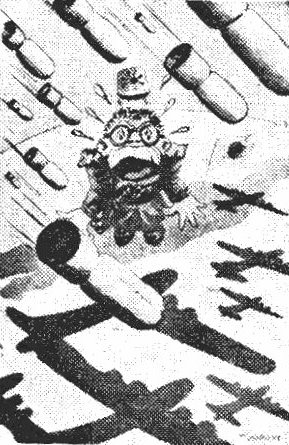
 It grows increasingly difficult to justify the Roundup's page one cheesecake offerings on the basis of
"news value." This week we just can't give you any devious reason for Ann Sothern's picture. Here it is -
you want it, and both of us damn well know why.
It grows increasingly difficult to justify the Roundup's page one cheesecake offerings on the basis of
"news value." This week we just can't give you any devious reason for Ann Sothern's picture. Here it is -
you want it, and both of us damn well know why.
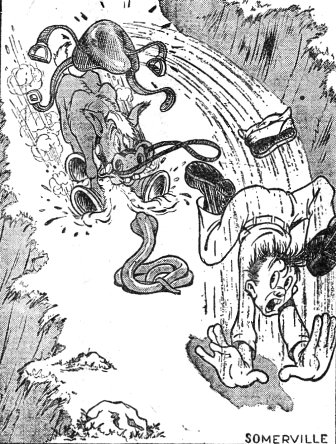 "GUESS HE DOESN'T LIKE SNAKES...!"
"GUESS HE DOESN'T LIKE SNAKES...!"
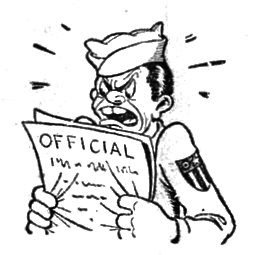
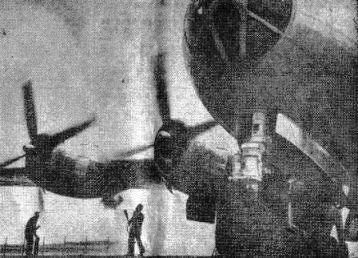 A head-on view of the gigantic B-29, showing the double wheel undercarriage. The plane bristles with armament,
blacked out for security reasons.
A head-on view of the gigantic B-29, showing the double wheel undercarriage. The plane bristles with armament,
blacked out for security reasons.
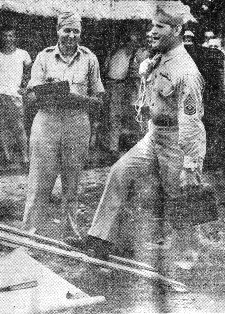 G.I.'s in the Skull and Wings Medium Bomb Squadron take their going home seriously. Here's 1st/Sgt. Joe Meier,
of Jersey City, N.J., doing gangplank drill, B bag and all. As Capt. Richard W. Maneval calls off his name,
Meier sounds off. Note dog tags around b=neck, tie, ribbons, all-around G.I. appearance. The sarge advocates
a practice for rotationists marking time to drop a cuss word a day from their vocabularies - for obvious reasons.
G.I.'s in the Skull and Wings Medium Bomb Squadron take their going home seriously. Here's 1st/Sgt. Joe Meier,
of Jersey City, N.J., doing gangplank drill, B bag and all. As Capt. Richard W. Maneval calls off his name,
Meier sounds off. Note dog tags around b=neck, tie, ribbons, all-around G.I. appearance. The sarge advocates
a practice for rotationists marking time to drop a cuss word a day from their vocabularies - for obvious reasons.
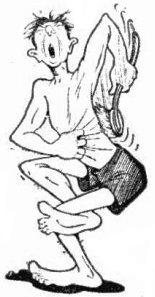
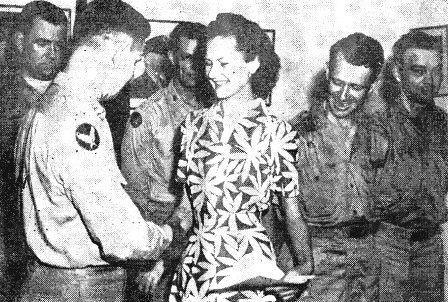 Miss Doreen B. Palmer receives the War Department's Emblem for meritorious Civilian Service from Maj. Gen.
George E. Stratemeyer, while big brass shifts around from one foot to t'other, in the background. Left to right:
Air Vice-Marshal T. M. Williams, Stratemeyer, Maj. H. W. Schaller, Miss Palmer, Col. A. R. Luedecke and Col.
N. M. Means.
Miss Doreen B. Palmer receives the War Department's Emblem for meritorious Civilian Service from Maj. Gen.
George E. Stratemeyer, while big brass shifts around from one foot to t'other, in the background. Left to right:
Air Vice-Marshal T. M. Williams, Stratemeyer, Maj. H. W. Schaller, Miss Palmer, Col. A. R. Luedecke and Col.
N. M. Means.
